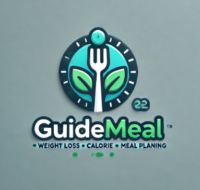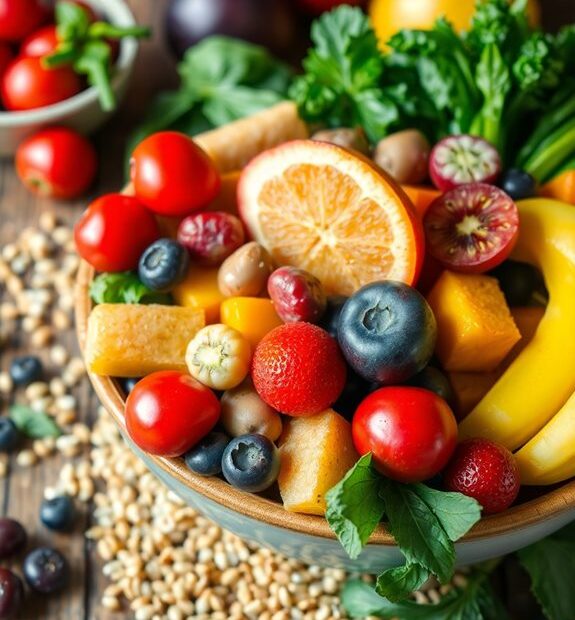Fiber plays a crucial role in your weight loss journey. It helps you feel full, which means fewer cravings for unhealthy snacks. Have you ever noticed how a hearty oatmeal breakfast keeps you satisfied longer? That's the beauty of fiber! It also supports digestion and boosts your energy. You can find fiber in fruits like apples and bananas, as well as in veggies like broccoli and whole grains like quinoa. By adding more fiber to your meals, you not only support weight loss but also your overall health. Stick around to discover more delicious ways to boost your fiber intake! 🍏🌍
Key Takeaways
- Fiber promotes satiety, reducing unhealthy snacking and overall calorie intake for effective weight loss.
- Soluble fiber aids in lowering cholesterol and stabilizing blood sugar, enhancing weight management.
- A balanced intake of soluble and insoluble fiber supports digestion and maintains overall health.
- Fiber-rich foods expand in the stomach, prolonging fullness and preventing premature hunger pangs.
- Integrating fiber into meals through fruits, vegetables, whole grains, and legumes boosts energy levels and satisfaction.
Importance of Fiber for Weight Loss
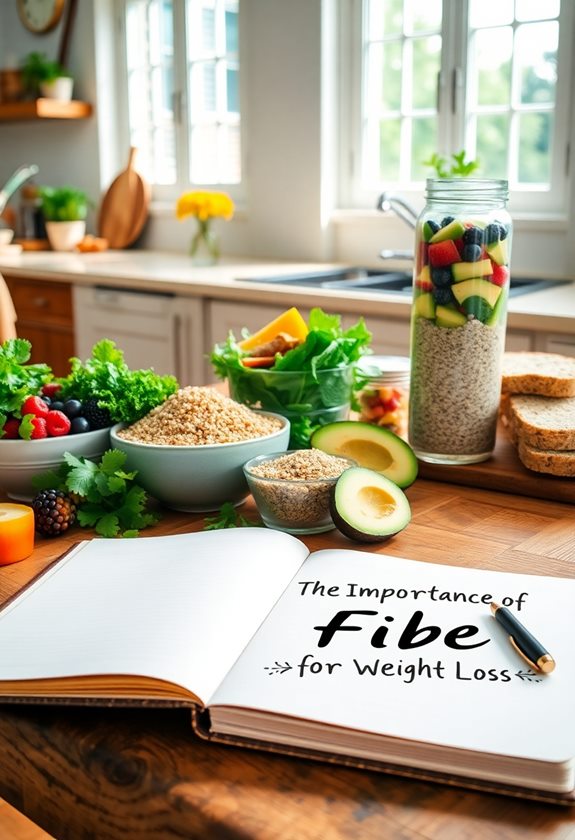
When it comes to weight loss, fiber plays an essential role in your diet. You might wonder, why is fiber so important? Well, it helps you feel full longer, which means you're less likely to snack on unhealthy foods. When you're trying to lose weight, feeling satisfied is key! Incorporating high-fiber foods into your meals, as suggested in various meal plan books, can enhance your weight loss journey.
Fiber also helps regulate your digestion. Ever felt bloated or uncomfortable after a meal? Increasing fiber can ease that feeling and keep your gut healthy. Plus, high-fiber foods often have fewer calories, making it easier to reach your weight loss goals without starving yourself.
Think about it: when you eat a bowl of oatmeal or munch on fresh veggies, you're giving your body what it needs to thrive. You'll not only lose weight but also gain energy!
Types of Dietary Fiber
Understanding the types of dietary fiber is key to maximizing its benefits for weight loss. There are two main types: soluble and insoluble fiber. Knowing the difference helps you make better food choices.
| Type of Fiber | Description |
|---|---|
| Soluble Fiber | Dissolves in water; helps lower cholesterol and blood sugar levels. Common sources include oats, beans, and fruits. 🍏 |
| Insoluble Fiber | Doesn't dissolve in water; adds bulk to your stool and aids digestion. You'll find it in whole grains, nuts, and vegetables. 🥦 |
So, why does it matter? Soluble fiber can keep you feeling full longer, while insoluble fiber helps keep your digestive system healthy. Incorporating both types into your diet can lead to better weight management. Have you ever noticed how certain foods fill you up more than others? That's the power of fiber at work!
When you're planning your meals, aim for a mix of both types. This balance can help keep cravings at bay and make your weight loss journey smoother. Remember, every little bit counts! 💪
Fiber-Rich Foods to Include
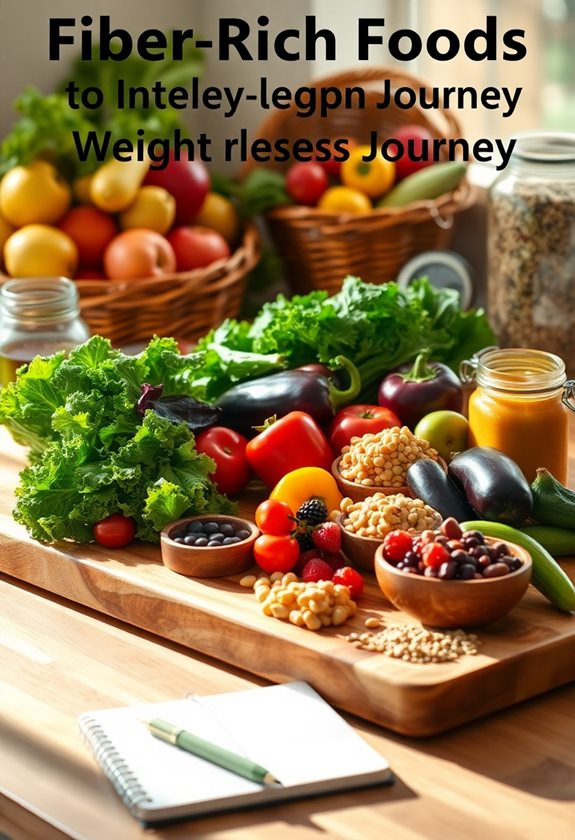
Including fiber-rich foods in your diet is essential for effective weight loss. Fiber not only helps you feel full but also supports your digestive health. Incorporating foods like organic green beans can add both fiber and essential nutrients to your meals, making them a great addition to any diet. So, what should you add to your meals? Here are some tasty options:
- Fruits 🍎: Apples, berries, and bananas are great choices. They're sweet, satisfying, and packed with fiber.
- Vegetables 🥬: Leafy greens like spinach and kale, as well as carrots and broccoli, can be easily added to any dish.
- Whole Grains 🍞: Swap white bread and pasta for whole grain versions. Quinoa, brown rice, or oats are excellent sources of fiber.
- Legumes 🌱: Beans, lentils, and chickpeas are not only rich in fiber but also super versatile. You can put them in salads, soups, or even make a delicious dip! Additionally, organic green beans are a fantastic option for those looking to enhance their meals with a nutritious, low-calorie vegetable that offers health benefits.
How Fiber Affects Appetite
How does fiber influence your appetite? It's pretty fascinating! When you eat fiber-rich foods, they expand in your stomach. This expansion sends signals to your brain that you're full. Have you ever noticed that you feel satisfied longer after munching on fruits, veggies, or whole grains? That's because fiber slows down digestion, which helps you avoid those annoying hunger pangs too soon. Incorporating a well-structured meal plan can further enhance this effect by ensuring you prioritize fiber-rich foods, which helps manage your calorie intake and supports your weight loss journey through the power of meal planning.
Additionally, fiber can help regulate your blood sugar levels. When your blood sugar stays steady, you're less likely to crave unhealthy snacks. Imagine how empowering it feels to have that control! Plus, fiber-rich foods often take longer to chew, giving you more time to enjoy your meal and feel full.
You might wonder how much fiber you need. Aiming for around 25-30 grams a day is a good start. Think about incorporating beans, nuts, or oats into your meals.
Tips for Increasing Fiber Intake
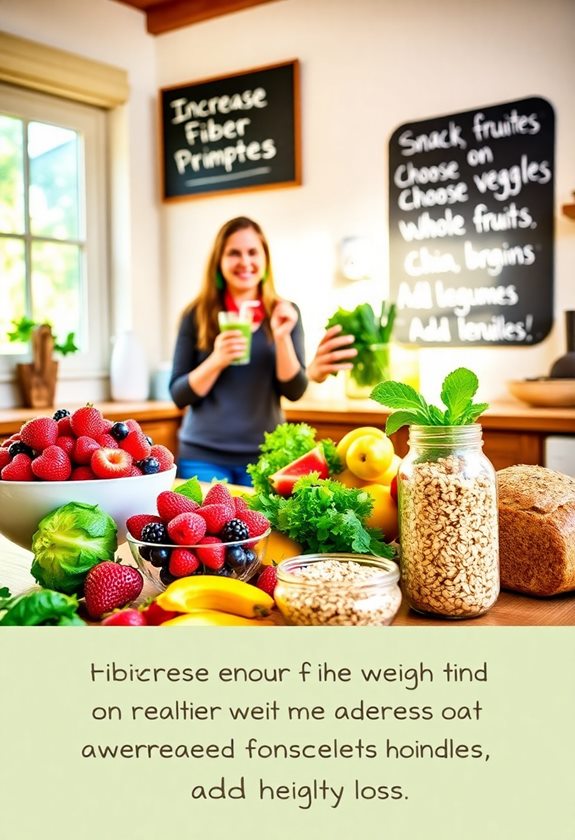
Boosting your fiber intake can be a game changer for your weight loss journey. It's easier than you might think! Here are some simple tips to help you add more fiber to your meals:
- Start your day right: Choose a high-fiber breakfast like oatmeal or whole-grain cereal. It'll keep you full longer and help curb those mid-morning cravings. 🌾
- Snack smart: Instead of chips, grab a piece of fruit or some raw veggies. Apples, carrots, and almonds are great choices that pack in fiber and nutrients. 🍏🥕
- Switch your grains: When you can, opt for whole grains instead of white bread or pasta. Whole grain options are richer in fiber and can help you feel satisfied. 🍞
- Add legumes: Beans, lentils, and chickpeas are excellent sources of fiber. Toss them into salads, soups, or even your favorite dishes for an easy boost. 🌱
Think about how these small changes can make a big difference. Are you ready to give them a try? By taking these steps, you'll be on your way to a healthier, more satisfying diet!
Fiber and Overall Health Benefits
But that's not all! Fiber also helps lower cholesterol levels, which can protect your heart. Imagine reducing your risk of heart disease just by adding a bit more fiber to your meals. Isn't that amazing? ❤️
Plus, fiber keeps you feeling full longer. This means you're less likely to snack on unhealthy foods. Who wouldn't like to feel satisfied after a meal?
Incorporating fiber into your diet can be simple. Start with small changes, like adding beans to your salad or snacking on nuts. Over time, you'll notice the positive impact on your health. So, why not take that step for your well-being? Your body will thank you! 😊
